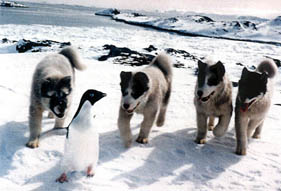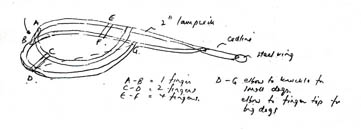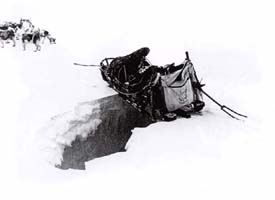Table of Contents
*
Featured Inuit Dog Owner: Ken MacRury, Part 1
*
Remembering Niya
*
Page from the Behaviour Notebook: Bishop and Tunaq
*
Antarctic Vignettes
*
On Managing ISD Aggression
*
The Qitdlarssuaq Chronicles, Part 3
*
News Briefs:
Inuit Dog Thesis Back in Print
Nunavut Quest 2003 Report
Article in Mushing Magazine
Possible Smithsonian Magazine Story
*
Product Review: Dismutase
*
Tip for the Trail: Insect Repellents
*
Book Review: The New Guide to Breeding
Old Fashioned Working Dogs
*
Video Review: Stonington Island, Antarctica 1957-58
*
IMHO: The Slippery Slope
Navigating This
Site
Index of articles by subject
Index
of back issues by volume number
Search The
Fan Hitch
Articles
to download and print
Ordering
Ken MacRury's Thesis
Our
comprehensive list of resources
Talk
to The
Fan Hitch
The Fan
Hitch home page
ISDI
home page
Editor: Sue Hamilton
Webmaster: Mark Hamilton
Contents of The Fan Hitch Website and its publications are protected by international copyright laws. No photo, drawing or text may be reproduced in any form without written consent. Webmasters please note: written consent is necessary before linking this site to yours! Please forward requests to Sue Hamilton, 55 Town Line Rd., Harwinton, Connecticut 06791, USA or mail@thefanhitch.org
Vignettes from Another Time, Another Place

A "youth gang" investigates the local
fauna
G. McLeod photo, 1962
Feeding dogs Nutty (pemmican)
The dogs are fed 450 gm blocks of Nutrican pemmican during
a
journey.
Each dog receives one block a day for two days and two
blocks on the
third
day. The food provides an average of 3,300 calories per
dog per day.
They
eat snow to rehydrate themselves. When thirsty their fur
becomes stiff:
well hydrated, their fur is silky. On the first day of a
journey we
remove
the thin paper wrapper from each block of pemmican so that
it does not
clog with the seal meat and bone remaining in their
stomachs from the
last
meal they had on base. The second day out we walk
down the night
span chucking each dog a paper wrapped block. The dogs
pounce on the
welcomed
food. Most crunch up the paper and the pemmican and
swallow it all.
Some
stand over the block, front legs straight, pressing it
into the snow
with
front paws while carefully removing the paper with their
incisor teeth.
The wrapper is discarded, and the block is consumed.
Isobel, I
have
noticed goes to the trouble of removing the wrapper then
eats it as a
starter
before the main pemmican
course.
Nick Cox
Stitching Dogs
We had checked the night trace but had not noticed that
some of the
chains are too long. Mac and Dex could just touch noses
and began to fight.
Mac got a hold of Dex by the nose, his jaws clamped tight.
Mac immediately
adopted that superior, blank, glazed stare. Like a
wrestler who had
his opponent in a perfect hold, enjoying the moment at the
expense of the
other's discomfort. Poor Dex squealed with pain, his
eyes focusing
all to closely on the line of teeth across the bridge of
his nose. We freed
Dex by inserting the back end of a ski between Mac's jaws,
levering them
gently open.
The fracas over, both dogs looked very pleased with themselves. Both sitting and wagging their tails with gusto while looking alternatively at me and each other. Mac had a big grin on his face, a string of blood stained saliva hanging from one side of his mouth. Dex was also grinning. There was a large hole in the bridge of Dex's nose, right between his eyes, the displaced flesh standing on end like the jagged top of a newly opened baked bean tin.
Settled in the tent, we prepared room indoors for Dex who would need a stitch in his wound. I filled a syring with 2ml acetylpromazine which would make Dex drowsy. I put the loaded syringe in the lunch break (vacuum) flask to help prevent the fluid from freezing at the base of the needle when I climbed into the cold air outside. I tied Dex on a short lead to the back of the sledge and injected the drug into his back leg. During the half hour it takes for the drug to take its effect, we cleared a space near the tunnel entrance to the tent. Dex was quite wobbly on his legs when I dragged him into our snug and warm world indoors. I dripped a little local anesthetic on the wound then waited a while Rudy sat astride the recumbent Dex and pushed the dog's head firmly onto the groundsheet. Waiving a needle and thread so close to his eyes it was important he stayed very still. The stitch work was far from smart but it pulled all the bits together and with a sprinkling of antibiotic powder on top, his face looked less of patchwork. Dex slept soundly in the tent. The doping drug we gave him takes a few hours to work off and during that period a dog lacks the ability to maintain its correct body heat. We had supper, melted ice in the billy ready for the morning brew, then slept.
The morning call was sudden and not as usual by the nasty Little Ben alarm clock perched on the pots box between us, but by a very wide awake and playful Dex, whose large square frame stood over me. Repeatedly he brought a front paw down in the middle of my chest. I sat up and cuddled his large wolf head. He then leapt over to see Rudy, sending primus, matches, meths, candle, and Little Ben flying. He then went round and round the seven foot square tent, stampeding over everything, including us, at every lap. I took him back to the night span. The wind was very strong. Nick Cox

Sketch of a lampwick harness with
dimensions
Training a Lead Dog With the Help of Doughnuts
(Smultring)
Niveak was a large deep chested dog who, we were told, had
led a team
for his previous owner for the past three years. Second
hand dog salesmen
are not unlike those who sell cars. Niveak meandered about
ahead of our
team oblivious of any commands we gave him. For
weeks Knut perservered
but there was little improvement. One morning before we
harnessed up the
two teams he had an idea. We received a bag of stale bread
from a local
supermarket which we occasionally gave to the dogs with
the dried fish
we got from Tromso. The last load they gave us included a
sack of smultring
(doughnuts) which we were going to throw out. Knut put a
dozen or so doughnuts
into a large white paper bag which we threw on the sledge.
The teams harnessed
and ready, he set off with Niveak leading. The giant Knut
sat cross legged
in the middle of his Greenland sledge cradling the
bag of doughnuts
in his lap. He said the bare minimum to his team,
expert at judging
when they were absorbed in their work, knowing when a word
from him would
interrupt their concentration. He called a command to
Niveak. "Hoyre" (right)
"Niveak". Like a ship responding to its wheel there is
sometimes a delay
before the turn comes. But in Niveak's case the wait would
go on forever.
There was no deflection from the route they were taking.
It was time for
the doughnuts. Knut shouted "Hoyre, Niveak" and threw a
doughnut ahead
and to the right. Niveak turned towards the doughnut
leading the team and
sledge behind him. The doughnut was scooped up and eaten
on the move and
the new course was set.
The doughnuts worked well left and right, and Niveak returned that afternoon having navigated a complex route of many miles. Knut knew from the start that it was Niveak's grand finale as a leader. A few journeys like that and he would be too fat to go anywhere. Nick Cox
A "Signature" Trail
Little Jock was rather shorter in the leg than most and
his chief claim
to fame was that in soft snow his penile member appeared
to plough a distinct
furrow down the center of his track when pulling a sledge.
As he insisted
on pulling well wide of the rest of the team it was always
very noticeable
but in no way was this detrimental of his ability to make
use of
it.
Jimmy Andrews
A Memorable Day!
It was less than a month from mid-winter so with limited
daylight only
a few hours of safe travel were possible each day. On this
occasion there
were two of us with two sledges and two teams. We
started the day
with a long, fast and very bumpy decent down a long slope
leading on to
the glacier. I was riding on the back of the sledge and
well remember the
sledge wheel breaking loose from its frame and passing me
at high speed.
It was last seen rolling off into the far distance and was
never seen again.
Also the dog Sherakin [was] strapped to the back of the
sledge as he was
very weak and ill and had to be physically restrained from
taking his place
in the team which would have weakened him even more. The
glacier we were
crossing was known to be badly crevassed so, after working
our way to the
middle, both sledges were stopped to assess the next part
of the route.
The day was dull and overcast, poor weather for working
among crevasses.
I was standing on my skis to the left and slightly behind
my sledge when
suddenly there was a noise - whoomph - and I was left
standing on the edge
of a deep hole with the tips of my ski over the edge of
what seemed a wide
and bottomless crevasse. The center of the bridge
had fallen away
leaving the sledge supported at its front and rear only.
For the time being
it did not look as if the sledge would fall further which
gave us time
to work out a method of retrieval. This was not easy
as, if the sledge
were to be moved a foot or two forward, the rear would
fall in and the
opposite would happen if we moved it backwards. There was
no way we could
get closer to the sledge to reduce its load. We decided
that the only solution
was to start the sledge with such power that it would
clear the crevasse
before the back end had a chance to fall in.
To give ourselves a chance of success we let the dogs rest for a while and then the driver of the leading sledge walked out a short way ahead of my dogs. On the command to go the other driver called to them, I gave a strong push from the rear and with an uncertain lurch my sledge cleared the crevasse.
A truly memorable day and not one I would like to repeat! Roger Scott

Scott's sledge spans the cravasse on
Swithinbank Glacier,
1973 Scott photo